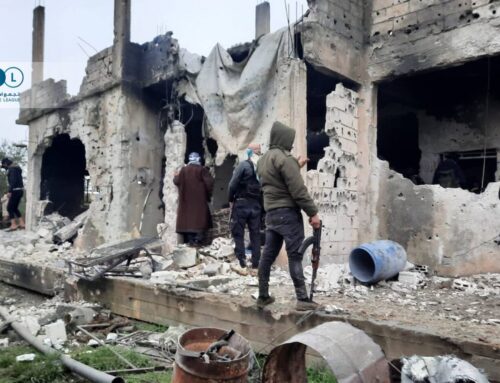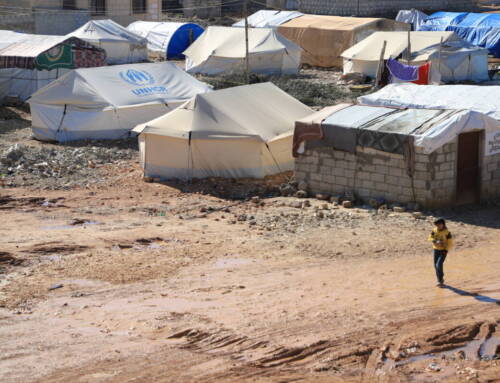Deir e-Zor ‘slowly being strangled by regime, Islamic State’
Since the Islamic State’s lightning advances in eastern Syria last […]
7 May 2015
Since the Islamic State’s lightning advances in eastern Syria last summer, the citizens of Deir e-Zor city have found themselves surrounded by IS forces on one side and regime forces on the other.
The main bridge connecting the provincial capital to its rural suburbs was destroyed in fighting last year and remains out commission. The city is little more than a prison, crippled by a double blockade. The Islamic State is not letting aid in or anyone out as the regime has encircled the parts of the city under IS control.
“The number of people in the blockade, and the proportion of people to area (and it is a very small area), makes the Deir e-Zor blockade the biggest, in terms of the number of people blockaded, since the beginning of the revolution,” says Jalal al-Hamd, a lawyer and spokesperson for the grassroots campaign “Together to Break the Siege on Deir e-Zor,” now living in Gaziantep, Turkey.
UN Secretary General Ban Ki Moon issued a report last month estimating that more than 225,000 civilians are living under IS rule in Deir e-Zor city, adding that no UN aid has reached them since May 2014. Water especially is a concern after IS fighters deactivated a local power point needed to provide water.
The lack of potable drinking water “is invoking fears of the spread of diseases and pandemics,” says Mujahid a-Shami the director of Deir e-Zor is Being Silently Slaughtered.
Below are excerpts from both interviews, conducted by Syria Direct’s Mohammed al-Haj Ali and Noura Hourani.
Talk about your awareness campaign and what you hope to accomplish.
Al-Hamd: This past March 20, after two months of the Deir e-Zor siege began, a group of media and human rights activists started the campaign “Together to break the siege on Deir e-Zor.” The campaign is a response to the encircled civilians calls for lifting of the blockade.

How many civilians are surrounded in the blockade?
Al-Hamd: There are more than 300,000 civilians in blockaded areas of the city, half of whom are women and children from families who were already displaced.
The number of people in the blockade, and the proportion of people to area (and it is a very small area), makes the Deir e-Zour blockade the biggest, in terms of number of people blockaded, since the beginning of the revolution.
What about civilian conditions in areas IS control that the regime has laid siege to?
Al-Shami: In the Deir e-Zor countryside, the situation is much worse. There is no longer electricity along with a rise in prices.
There is a widespread condition of poverty and no potable drinking water.
Al-Hamd: I’d like to add that since the beginning of the blockade, Deir e-Zor city gets two hours of electricity every day, just as the water is cut off for most of the day.
What are the civilians doing with regard to food and drink? Has IS allowed aid to enter the neighborhoods under their control?
Al-Hamd: IS has absolutely refused to allow any food or medicine aid to areas under its control. They have arrested a number of drivers that trying to bring aid. IS also prevents anyone from entering or leaving the city, which has led to widespread hunger among the civilians.
You mentioned that potable drinking water isn’t available. Why not?
Al-Shami: Water for general use exists, however clean water for drinking isn’t available because of a lack of chlorine that is used in the water plant to sterilize the water. This is invoking fears of the spread of diseases and pandemics.
What are the practices undertaken by IS to restrict the people that live under their control?
Al-Shami: IS practices the same starvation policy that the regime uses on people. They forbid people from leaving the region to migrate to other areas. They also burden the people with taxes.
They have imposed taxes on everything and everyone: electricity, water, communications, and even the houses, stores, and street vendors.
You said that the people are suffering from severe poverty. What is the fate of those without money to pay these taxes?
Al-Shami: There are punitive steps that IS takes in this instance and the punishments differ. Some are arrested, others are sentenced to hard labor such as digging trenches and tunnels that IS digs. Others are sent to fight.
As the director of the “Deir e-Zor is Being Silently Slaughtered” campaign and as someone from Deir e-Zor, what is the message that you would like to send?
Al-Shami:I hope to direct the world’s attention to what is happening and to lift the siege on the people who are being strangled slowly by the two sides: the regime and the Islamic State.
Has there been any response to the campaign?
Al-Hamd:At the time of this interview, there hasn’t been any response from any organization.
The people of Deir al-Zour are not begging; they are calling for their right to live a dignified life.







